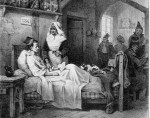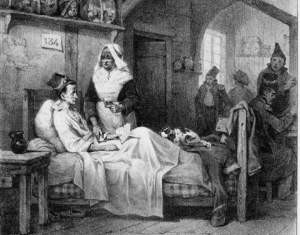
 Le mal du pays, Lithographie d’Hippolyte Bellangé, 1832, B.N.F.
Le mal du pays, Lithographie d’Hippolyte Bellangé, 1832, B.N.F.
Where nostalgia today refers to a fairly common, benign feeling, not altogether lacking in mellowness (the melancholy yearnings for a long-gone past), nostalgia was once a fearful illness that wreaked havoc among the military and colonists far from their native land. Indeed, the word “nostalgia” designated, from the end of the 18th century, the ache (algos) for homecoming (nostos) or “homesickness”. This effect was first diagnosed by Johannes Hofer in the Germanic space in 1688: he used the term to describe the distress felt by Swiss mercenaries far from home. It is said that the traditional Swiss milking song, Ranz des Vaches, caused in these soldiers a nostalgic angst so deep that it was banned from these troops’ musical repertoire. A century later, the French discovered in their turn the devastating effects of this condition as a great many soldiers who had joined in the 1793 mass levy died in service with no perceptible cause, to the extent that nostalgia-stricken soldiers would become the only ones to be granted leave. This first wave of nostalgia would be followed by many more: The Revolutionary then Imperial wars, the Morean then the Crimean wars, and even the colonisation of Algeria all registered a significant mortality due to the illness. Yet was nostalgia actually an illness? Military doctors, producing abundant research on the matter were soon persuaded of the fact, which did not resolve the problems they faced in producing a definition of the condition. Nostalgia proved to present in vastly diverse ways. In its dire form, patients withdrew into mutism and apathy, refused to eat, and ended up dying in an enfeebled and spent state. Nostalgia affected especially young recruits, away from home for the first time, and subjected to a military discipline they were unfamiliar with. In France it also raged among those hailing from the more remote, highly distinctive regions, notably the Corsicans, the Bretons, the Basques and, more broadly, mountain folks; it affected country dwellers more than townies.
Nostalgia never achieved medical unanimity and several different definitions have co-existed and followed on each other. In the late 18th and early 19th century, the neo-Hippocratic definition prevailed. Nostalgia was thought to be caused by a person’s estrangement from their natural environment. In the 19th century, anatomical pathology, founded in the auscultation of the patient and a precise description of symptoms, in the face of its many and manifold individual manifestations, struggled to outline a precise profile of nostalgia. It also sought to resolve the enigma of nostalgia’s seat. Was it activated in the brain or in the stomach? For the most part physicians favoured the first option. It is doubtless the numerous psychology-driven symptoms (profound sadness, listlessness, tears) that explain alienist physicians’ early interest in nostalgia. Under the Restoration, the alienist Philippe Pinel, nudged nostalgia’s diagnosis towards mental pathology, placing it in the very broad category of monomanias (deliria in which the mind is fixated on one single object, here homecoming.) The only remedy consisted in sending the patient back home.
Nostalgia represented a genuine threat to French military and colonial expansion. Beyond expeditionary forces, it also massively affected the French settlers dispatched to populate the “villages agricoles” of the new Algerian colony in 1848. A healthcare and political issue, nostalgia also represented, paradoxically, a reassuring proof of the French people’s cohesion, of the depth of their attachment to their home patch, itself a token of the love for the homeland as a whole. As the 19th century wore on, pathological nostalgia gradually disappeared in the wake of a reflexion on “acclimating”: it proved possible, through gentle progress, to adjust French folks to a hitherto foreign environment (be it the military realm or Colonial Algeria). Officers were accordingly advised to recreate a family atmosphere within their units and churches were erected in Algerian villages with steeples reminiscent of the motherland. Through an unexpected reversal, the Bretons became in the Second Empire ideal prospective migrants because they were deemed able to recreate their home patch in Algeria. Further on, the development of railways and steamships contributed, according to physicians, to generalise travel and immunise the French against nostalgia.
The appearance of pathological nostalgia and its gradual disappearance is closely related to the broader political process that fostered the nesting regional, national and imperial identities that evolved over the 19th century.
Read more in the dictionary : Tattoos
Read the paper in French : Nostalgie
Références :
Thomas Dodman, "" Un pays pour la colonie" Mourir de nostalgie en Algérie française, 1830-1880", Annales. Histoire, Sciences Sociales, 2011, p. 743-784.
Sylvain Venayre, "Le corps malade du désir du pays natal. Nostalgie et médecine au XIXe siècle", in Anne-Emmanuelle Demartini et Dominique Kalifa (dir.), Imaginaire et sensibilités au XIXe siècle. Études pour Alain Corbin, Créaphis, 2005, p. 209-222.
To quote this paper : Stéphanie Soubrier, “Nostalgia”, in Hervé Guillemain (ed.), DicoPolHiS, Le Mans Université, 2022.